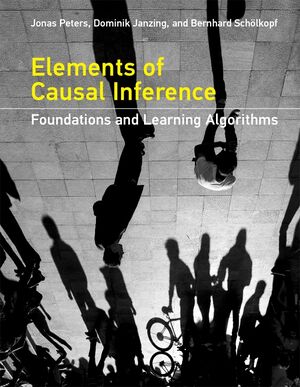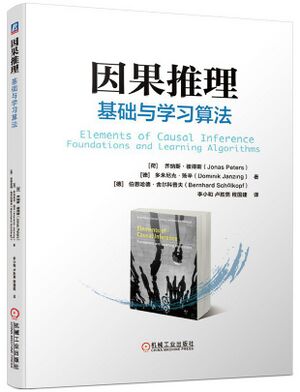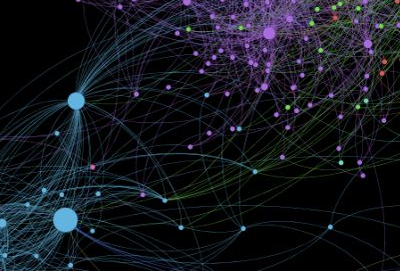“Elements of Causal Inference: Foundations and Learning Algorithms”的版本间的差异
(→编者推荐) |
|||
| 第318行: | 第318行: | ||
===豆瓣书评[https://book.douban.com/subject/27088754/]=== | ===豆瓣书评[https://book.douban.com/subject/27088754/]=== | ||
“又是一本当年自己没看懂觉得很无聊 现在发现是神作的书……” ——'''一般翼赞员''' | “又是一本当年自己没看懂觉得很无聊 现在发现是神作的书……” ——'''一般翼赞员''' | ||
| + | |||
“主要就介绍作者们这几年发的论文工作,除此以外的部分就是宽泛的文献综述了。没太多细节。” ——'''周末''' | “主要就介绍作者们这几年发的论文工作,除此以外的部分就是宽泛的文献综述了。没太多细节。” ——'''周末''' | ||
2022年6月19日 (日) 22:16的最新版本
内容简介-英文
The mathematization of causality is a relatively recent development, and has become increasingly important in data science and machine learning. This book offers a self-contained and concise introduction to causal models and how to learn them from data. After explaining the need for causal models and discussing some of the principles underlying causal inference, the book teaches readers how to use causal models: how to compute intervention distributions, how to infer causal models from observational and interventional data, and how causal ideas could be exploited for classical machine learning problems. All of these topics are discussed first in terms of two variables and then in the more general multivariate case. The bivariate case turns out to be a particularly hard problem for causal learning because there are no conditional independences as used by classical methods for solving multivariate cases. The authors consider analyzing statistical asymmetries between cause and effect to be highly instructive, and they report on their decade of intensive research into this problem.
The book is accessible to readers with a background in machine learning or statistics, and can be used in graduate courses or as a reference for researchers. The text includes code snippets that can be copied and pasted, exercises, and an appendix with a summary of the most important technical concepts.
内容简介-中文
《因果推理:基础与学习算法》从概率统计的角度入手,分析了因果推理的假设,揭示这些假设所暗示的因果推理和学目的。本书分别论述了变量和多变量情况下的因果模型、学习因果模型及其与机器学关系,讨论了因果推理隐藏变量有关的问题、时间系列的因果分析。 《因果推理:基础与学习算法》可作为高等院校人工智能和计算机科学等相关专业高年级本科生和硕士研究生的教材,也可供研究机器学习、因果推理的技术人员参考。
基本信息
书名:Elements of Causal Inference: Foundations and Learning Algorithms
作者:Jonas Peters/Dominik Janzing/Bernhard Schölkopf
中文翻译版:因果推理基础与学习算法
译者: 李小和 / 卢胜男 / 程建国
作者介绍
Jonas Peters
Jonas Peters是哥本哈根大学数学科学系的统计学教授。此前,他曾担任图宾根马克斯-普朗克智能系统研究所的组长和苏黎世联邦理工学院统计研讨会的玛丽居里研究员。他在海德堡大学和剑桥大学学习数学,并在 MPI 和 ETH 联合获得博士学位。他感兴趣的是从不同类型的数据中推断因果关系,以及建立对分布变化具有鲁棒性的统计方法。在他的研究中,乔纳斯试图将理论、方法和应用结合起来。他的工作涉及计算统计、因果推理、图形模型、独立性测试或高维统计等领域。
Dominik Janzing
Dominik Janzing是位于德国图宾根的马克思·普朗克智能系统研究所的高级研究科学家,现在致力于从统计数据进行因果推理和新的因果推理规则的基础。
Bernhard Schölkopf
Bernhard Schölkopf是位于德国图宾根的马克思·普朗克智能系统研究所所长。他是《用核函数学习》(2002)的合著者,也是《核函数方法的进展:支持向量学习》(1998)、《大边缘分类器的进展》(2000)和《计算生物学中的核函数方法》(2004)的共同编辑。他还是苏黎世联邦理工学院的附属教授,蒂宾根大学和柏林工业大学的名誉教授,以及欧洲学习与智能系统实验室(ELLIS) 的主席。
内容目录
前言
符号和术语
第1章 统计和因果模型
1.1 概率论与统计学
1.2 学习理论
1.3 因果建模和学习
1.4 实例
1.4.1 模式识别
1.4.2 基因干扰
第2章 因果推断假设
2.1 独立机制原则
2.2 历史记录
2.3 因果模型的物理结构
2.3.1 时间的作用
2.3.2 物理定律
2.3.3 循环赋值
2.3.4 干预的可行性
2.3.5 原因和机制的独立性以及时间的热力学之箭
第3章 原因-效果模型
3.1 结构因果模型
3.2 干预
3.3 反事实
3.4 结构因果模型的标准表示
3.5 问题
第4章 学习原因-效果模型
4.1 结构可识别性
4.1.1 为什么需要额外的假设
4.1.2 假设类型的概述
4.1.3 非高斯加性噪声的线性模型
4.1.4 非线性加性噪声模型
4.1.5 离散加性噪声模型
4.1.6 后非线性模型
4.1.7 信息-几何因果推断
4.1.8 Trace方法
4.1.9 以算法信息理论为可能的基础
4.2 结构识别方法
4.2.1 加性噪声模型
4.2.2 信息几何因果推断
4.2.3 Trace方法
4.2.4 监督学习方法
4.3 问题
第5章 与机器学联系1
5.1 半监督学习
5.1.1 半监督学习和因果方向
5.1.2 关于半监督学习在因果方向上的注释
5.2 协变量偏移
5.3 问题
第6章 多变量因果模型
6.1 图的术语
6.2 结构因果模型
6.3 干预
6.4 反事实
6.5 马尔可夫性、忠实性和因果小性
6.5.1 马尔可夫性
6.5.2 因果图模型
6.5.3 忠实性和因果小性
6.6 通过协变量调整计算干预分布
6.7 do-calculus
6.8 因果模型的等价性和可证伪性
6.9 潜在的结果
6.9.1 定义与实例
6.9.2 潜在的结果与结构因果模型之间的关系
6.10 单一对象的广义结构因果模型
6.11 条件算法独立性
6.12 问题
第7章 学习多变量因果模型
7.1 结构可识别性
7.1.1 忠实性
7.1.2 加性噪声模型
7.1.3 具有等误差方差的线性高斯模型
7.1.4 线性非高斯无环模型
7.1.5 非线性高斯加性噪声模型
7.1.6 观测数据和实验数据
7.2 结构识别方法
7.2.1 基于独立的方法
7.2.2 基于分数的方法
7.2.3 加性噪声模型
7.2.4 已知因果次序
7.2.5 观测数据与实验数据
7.3 问题
第8章 与机器学联系2
8.1 半同胞回归
8.2 因果推断与场景强化学习
8.2.1 逆概率加权
8.2.2 场景强化学习
8.2.3 21点(Blackjack)中的状态简化
8.2.4 改进广告布置的加权
8.3 域适应
8.4 问题
第9章 隐藏变量
9.1 干预充分性
9.2 Simpson悖论
9.3 工具变量
9.4 条件独立性和图表示
9.4.1 图
9.4.2 快速因果推断
9.5 条件独立性之外的约束
9.5.1 Verma约束
9.5.2 不等式约束
9.5.3 基于协方差的约束
9.5.4 附加噪声模型
9.5.5 检测低复杂度混杂因子
9.5.6 不同的环境
9.6 问题
第10章 时间序列
10.1 基础和术语
10.2 结构因果模型和干预
10.2.1 下采样
10.3 学习因果时间序列模型
10.3.1 马尔可夫条件和忠实性
10.3.2 一些不要求忠实性的因果结论
10.3.3 Granger因果关系
10.3.4 具有受限函数类的模型
10.3.5 频谱独立准则
10.4 动态因果建模
10.5 问题
附录
附录A 一些概率与统计学基础知识
A.1 基本定义
A.2 独立性以及条件独立性测试
A.3 函数类的容量
附录B 因果次序和邻接矩阵
附录C 证明
C.1 定理4.2的证明
C.2 命题6.3的证明
C.3 备注6.6的证明
C.4 命题6.13的证明
C.5 命题6.14的证明
C.6 命题6.36的证明
C.7 命题8的证明
C.8 命题9的证明
C.9 命题7.1的证明
C.10 命题7.4的证明
C.11 命题8.1的证明
C.12 命题8.2的证明
C.13 命题9.3的证明
C.14 命题10.3的证明
C.15 定理10.4的证明
参考文献
资源获取
相关wiki
编者推荐
豆瓣书评[1]
“又是一本当年自己没看懂觉得很无聊 现在发现是神作的书……” ——一般翼赞员
“主要就介绍作者们这几年发的论文工作,除此以外的部分就是宽泛的文献综述了。没太多细节。” ——周末
Goodreads书评[2]
“This book provides a nice introduction into today's causal inference research. For a person like me who is vaguely interested in the topic, but 1) find classical writings like Pearl's to be difficult to understand because they are not written in the language of modern statistics & machine learning, and 2) want to get an overview of today's rapid & diverse research on the topic, this book is a perfect fit. Authors explain key ideas of causal inference in modern terminologies of machine learning, and I found it much more readable than others. They also cover a wide spectrum of ongoing approaches and issues in the field, and make insightful connections between them. Since the book covers so many topics, however, most topics are only sketchily touched, and technical proofs are mostly left out. Moreover, authors concentrate mostly on theoretical issues (ex: identifiability) and applications to real-world problems are only occasionally discussed. This book only serves as a starting point, and you need to follow references to really understand any topic; I expected deeper and gentler dive, at least for key concepts. I also found latter half of the book to be not as carefully written as in the beginning; so many parentheses and hyphens, which are quite distracting.” ——Hyokun Yun
“After reading "The Book of Why", I was looking for a more technical introduction to causality. Since by background in machine learning using kernel methods, this book co-authored by Bernhard Schölkopf seemed a good start.Though I skimmed through the latter chapters, the beginning gives a good introduction to the different types of causality and which assumptions that have to be made. I especially liked the chapters drawing links between causality and topics like transfer learning and domain adaptation!” ——Michiel
集智俱乐部读书会推荐
因果推理与机器学习读书会
大数据时代的下一场变革——因果革命正在酝酿之中,通过融合因果推理和机器学习而构建出来的Causal AI系统,有望奠定强人工智能的基石。集智俱乐部联合北京智源人工智能研究院,邀请了一批对因果科学与Casual AI感兴趣的研究者,开展为期2-3个月的系列线上读书会,研读经典和前沿论文,并尝试集体撰写一部书籍。
集智俱乐部相关文章
图模型与因果推理基础- SCM框架和Do-Calculus
- 本文主要串讲了Pearl因果识别框架的基础知识,包括图模型、结构因果模型的范式,三种识别策略,以及如何运用do- calculus的三种规则来进行因果识别。本篇内容整理自因果科学读书会第一季。
第二种想象力:社会科学中的因果推断
- 本文中南京大学陈云松教授从“因果”和“数据”两个维度,用因果推断、大数据和机器学习等方面的系列研究案例,阐释第二种想象力的八类思维面向。
因果科学的学习路线图
- 本文主要根据对因果推断引擎的介绍,为关注因果科学领域的初学者提供了完整的学习路径
本中文词条由因果读书会词条梳理志愿者一尾鱼编辑,未经专家审核,带来阅读不便,请见谅。
本词条内容源自wikipedia及公开资料,遵守 CC3.0协议。


